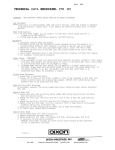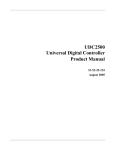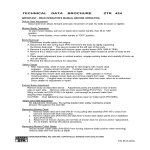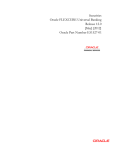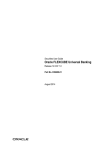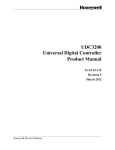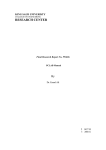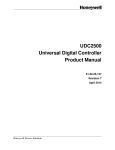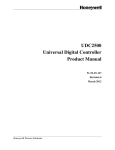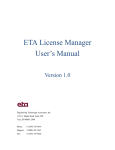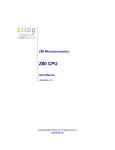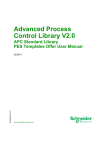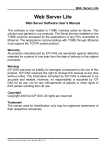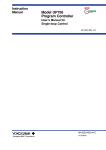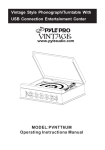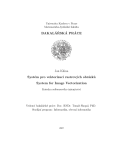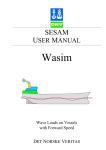Download Sherpa Predictive Control Library V3.0
Transcript
EIO0000000107 10/2008 Sherpa Predictive Control Library V3.0 for Unity Pro and Concept EIO0000000107.00 10/2008 www.schneider-electric.com © 2008 Schneider Electric. All rights reserved. 2 EIO0000000107 10/2008 Table of Contents Safety Information . . . . . . . . . . . . . . . . . . . . . . . . . . . . . About the Book . . . . . . . . . . . . . . . . . . . . . . . . . . . . . . . . 5 7 Part I General Information . . . . . . . . . . . . . . . . . . . . . . . . 9 Chapter 1 Using the Sherpa Predictive Control Library with Unity Pro or Concept . . . . . . . . . . . . . . . . . . . . . . . . . . . 11 Using the Sherpa Predictive Control Library with Unity Pro or Concept Unity Pro: Block Availability on the Various Hardware Platforms . . . . . Concept: Block Availability on the Various Hardware Platforms . . . . . . 12 13 14 Chapter 2 Predictive Control. . . . . . . . . . . . . . . . . . . . . . . . . . . . . . 15 General Principles of Model Based Predictive Control . . . . . . . . . . . . . Sherpa Predictive Control Description . . . . . . . . . . . . . . . . . . . . . . . . . 16 19 Part II EFB Descriptions . . . . . . . . . . . . . . . . . . . . . . . . . 21 Chapter 3 PCR_SF1: Simple Predictive Controller for First Order Process . . . . . . . . . . . . . . . . . . . . . . . . . . . . . . . . . . . . . . 23 Brief Description . . . . . . . . . . . . . . . . . . . . . . . . . . . . . . . . . . . . . . . . . . Detailed Description . . . . . . . . . . . . . . . . . . . . . . . . . . . . . . . . . . . . . . . 24 28 Chapter 4 PCR_EF1: Enhanced Controller: First Order with Feed-Forward, Cascade, Split Range, Self Compensation. . . . . . . . . . . . . . . . . . . . . . . . . . . . . . . . . 29 Brief Description . . . . . . . . . . . . . . . . . . . . . . . . . . . . . . . . . . . . . . . . . . Detailed Description . . . . . . . . . . . . . . . . . . . . . . . . . . . . . . . . . . . . . . . 30 35 Chapter 5 PCR_IF1: Controller for Integrative First Order Process . . . . . . . . . . . . . . . . . . . . . . . . . . . . . . . . . . . . . . 37 Brief Description . . . . . . . . . . . . . . . . . . . . . . . . . . . . . . . . . . . . . . . . . . 37 Chapter 6 PCR_EIF1: Enhanced Controller: Integrative First Order Process with Feed-Forward, Cascade, Ramp Set Point . . . . . . . . . . . . . . . . . . . . . . . . . . . . . . . . . . . . . 41 Brief Description . . . . . . . . . . . . . . . . . . . . . . . . . . . . . . . . . . . . . . . . . . Detailed Description . . . . . . . . . . . . . . . . . . . . . . . . . . . . . . . . . . . . . . . 42 46 EIO0000000107 10/2008 3 Chapter 7 PCR_RD1: Ramp and Docking Set Point Controller for First Order Process . . . . . . . . . . . . . . . . . . . . . . . . . . . . 48 53 Chapter 8 PCR_DC3: Dedicated Controller for Third Order Process . . . . . . . . . . . . . . . . . . . . . . . . . . . . . . . . . . . . . . 55 Brief Description. . . . . . . . . . . . . . . . . . . . . . . . . . . . . . . . . . . . . . . . . . 55 Chapter 9 PCR_ZTR: Zone Control with Non-Linear Time Response . . . . . . . . . . . . . . . . . . . . . . . . . . . . . . . . . . . . 59 Brief Description. . . . . . . . . . . . . . . . . . . . . . . . . . . . . . . . . . . . . . . . . . Detailed Description. . . . . . . . . . . . . . . . . . . . . . . . . . . . . . . . . . . . . . . 60 62 Chapter 10 PCR_FIL: Rate Limiter Filter . . . . . . . . . . . . . . . . . . . . . 65 Brief Description. . . . . . . . . . . . . . . . . . . . . . . . . . . . . . . . . . . . . . . . . . Detailed Description. . . . . . . . . . . . . . . . . . . . . . . . . . . . . . . . . . . . . . . 66 68 Chapter 11 PCR_RSP: Ramp and Docking Set Point Generator . 71 Brief Description. . . . . . . . . . . . . . . . . . . . . . . . . . . . . . . . . . . . . . . . . . 71 Chapter 12 PCR_FF1: Model for First Order Feed-Forward Compensation . . . . . . . . . . . . . . . . . . . . . . . . . . . . . . . . 77 Brief Description. . . . . . . . . . . . . . . . . . . . . . . . . . . . . . . . . . . . . . . . . . Detailed Description. . . . . . . . . . . . . . . . . . . . . . . . . . . . . . . . . . . . . . . 78 81 Chapter 13 PCR_IFF1: Model for Feed-Forward Compensation Used with Integrative First Order System . . . . . . . . . . 83 Brief Description. . . . . . . . . . . . . . . . . . . . . . . . . . . . . . . . . . . . . . . . . . Detailed Description. . . . . . . . . . . . . . . . . . . . . . . . . . . . . . . . . . . . . . . 84 87 Chapter 14 PCR_SR1: Supervisor for 2 Controllers in Split Range Configuration . . . . . . . . . . . . . . . . . . . . . . . . . . . . . . . . . 4 47 Brief Description. . . . . . . . . . . . . . . . . . . . . . . . . . . . . . . . . . . . . . . . . . Detailed Description. . . . . . . . . . . . . . . . . . . . . . . . . . . . . . . . . . . . . . . 89 Brief Description. . . . . . . . . . . . . . . . . . . . . . . . . . . . . . . . . . . . . . . . . . Detailed Description. . . . . . . . . . . . . . . . . . . . . . . . . . . . . . . . . . . . . . . 90 92 Chapter 15 PCR_ESR1: Enhanced Split Range Supervisor with Min Constraints Different from Zero . . . . . . . . . . . . . . 95 Brief Description. . . . . . . . . . . . . . . . . . . . . . . . . . . . . . . . . . . . . . . . . . Detailed Description. . . . . . . . . . . . . . . . . . . . . . . . . . . . . . . . . . . . . . . 96 100 Index . . . . . . . . . . . . . . . . . . . . . . . . . . . . . . . . . . . . . . . . . 101 EIO0000000107 10/2008 Safety Information § Important Information NOTICE Read these instructions carefully, and look at the equipment to become familiar with the device before trying to install, operate, or maintain it. The following special messages may appear throughout this documentation or on the equipment to warn of potential hazards or to call attention to information that clarifies or simplifies a procedure. EIO0000000107 10/2008 5 PLEASE NOTE Electrical equipment should be installed, operated, serviced, and maintained only by qualified personnel. No responsibility is assumed by Schneider Electric for any consequences arising out of the use of this material. 6 EIO0000000107 10/2008 About the Book At a Glance Document Scope This document describes the function blocks of the Sherpa Predictive Control library. This document is valid for the Sherpa Predictive Control library version 3.0. Validity Note This documentation applies to Unity Pro 2.3 and later and to Concept 2.5 and later. The data and illustrations found in this document are not binding. We reserve the right to modify our products in line with our policy of continuous product development. The information in this document is subject to change without notice and should not be construed as a commitment by Schneider Electric. Related Documents Title of Documentation Reference Number Unity Pro, Program Languages and Structure, Reference Manual - Concept User Manual 33002204 You can download these technical publications and other technical information from our website at www.schneider-electric.com. Product Related Information Schneider Electric assumes no responsibility for any errors that may appear in this document. If you have any suggestions for improvements or amendments or have found errors in this publication, please notify us. No part of this document may be reproduced in any form or by any means, electronic or mechanical, including photocopying, without express written permission of Schneider Electric. EIO0000000107 10/2008 7 All pertinent state, regional, and local safety regulations must be observed when installing and using this product. For reasons of safety and to ensure compliance with documented system data, only the manufacturer should perform repairs to components. When controllers are used for applications with technical safety requirements, please follow the relevant instructions. Failure to use Schneider Electric software or approved software with our hardware products may result in injury, harm, or improper operating results. Failure to observe this product related warning can result in injury or equipment damage. User Comments We welcome your comments about this document. You can reach us by e-mail at [email protected]. 8 EIO0000000107 10/2008 General Information EIO0000000107 10/2008 General Information I Introduction This part contains general information about the Sherpa Predictive Control library. What's in this Part? This part contains the following chapters: Chapter EIO0000000107 10/2008 Chapter Name Page 1 Using the Sherpa Predictive Control Library with Unity Pro or Concept 11 2 Predictive Control 15 9 General Information 10 EIO0000000107 10/2008 Using Sherpa Predictive Control Library with Unity Pro or Concept EIO0000000107 10/2008 Using the Sherpa Predictive Control Library with Unity Pro or Concept 1 Introduction You can use the Sherpa Predictive Control library with Unity Pro or with Concept. What's in this Chapter? This chapter contains the following topics: Topic EIO0000000107 10/2008 Page Using the Sherpa Predictive Control Library with Unity Pro or Concept 12 Unity Pro: Block Availability on the Various Hardware Platforms 13 Concept: Block Availability on the Various Hardware Platforms 14 11 Using Sherpa Predictive Control Library with Unity Pro or Concept Using the Sherpa Predictive Control Library with Unity Pro or Concept Introduction You can use the Sherpa Predictive Control library with Unity Pro or with Concept. Related Documents For further details on how to use EFBs with Unity Pro or Concept (for example EN and ENO), please refer to the respective documentation. z For Unity Pro please refer to Unity Pro, Program Languages and Structure, Reference Manual. z For Concept please refer to Concept User Manual. 12 EIO0000000107 10/2008 Using Sherpa Predictive Control Library with Unity Pro or Concept Unity Pro: Block Availability on the Various Hardware Platforms Introduction Block availability by hardware platform can be found in the following table. Block Availability Group Block Name Block Type M340 Premium Quantum Controller PCR_SF1 EFB + + + PCR_EF1 EFB + + + PCR_IF1 EFB + + + Generator Model Supervisor PCR_EIF1 EFB + + + PCR_RD1 EFB + + + PCR_DC3 EFB + + + PCR_ZTR EFB + + + PCR_FIL EFB + + + PCR_RSP EFB + + + PCR_FF1 EFB + + + PCR_IFF1 EFB + + + PCR_SR1 EFB + + + PCR_ESR1 EFB + + + Legend: EIO0000000107 10/2008 + yes - no 13 Using Sherpa Predictive Control Library with Unity Pro or Concept Concept: Block Availability on the Various Hardware Platforms Introduction Block availability by hardware platform can be found in the following table. Block Availability Group Block Name Block Type Atrium Quantum Momentum Compact Controller PCR_SF1 EFB + + + + PCR_EF1 EFB + + + + PCR_IF1 EFB + + + + PCR_EIF1 EFB + + + + PCR_RD1 EFB + + + + Generator Model Supervisor PCR_DC3 EFB + + + + PCR_ZTR EFB + + + + PCR_FIL EFB + + + + PCR_RSP EFB + + + + PCR_FF1 EFB + + + + PCR_IFF1 EFB + + + + PCR_SR1 EFB + + + + PCR_ESR1 EFB + + + + Legend: 14 + yes - no EIO0000000107 10/2008 Predictive Control EIO0000000107 10/2008 Predictive Control 2 Introduction This chapter provides information about the general principles of predictive control and general information about Sherpa Predictive Control. What's in this Chapter? This chapter contains the following topics: Topic EIO0000000107 10/2008 Page General Principles of Model Based Predictive Control 16 Sherpa Predictive Control Description 19 15 Predictive Control General Principles of Model Based Predictive Control Introduction A model based predictive controller is a controller that uses a model in real time for the computation of the control action to be applied. The main aspects of this controller are given below. Model The model which is embedded in the controller is a mathematical equation that computes a 'model' output which is comparable to the process output PV (Process Variable). The model represents the relationship linking the process input(s) to the process output. This model must be identified: the parameters of the model are to be estimated from recorded plant tests. The model is used to predict the process output and to compute the control action in order to satisfy a given target specified on the PV. 16 EIO0000000107 10/2008 Predictive Control Future Desired Trajectory At present time (n), the process output is PV(n) and the set point value is SP(n). The future desired trajectory (so-called reference trajectory) is the desired behavior of the process output to move from its present value PV(n) to SP(n) in the future. The reference trajectory is computed by a first order system (see above) and the response time of this trajectory is the closed loop response time: the PV will respond to a set point step change with the response time given by the user. The closed loop response time (TRBF) is a specification which defines the strength or the smoothness of the controller. There is a trade-off between dynamic performance and robustness. The controller is more robust when the specified TRBF is longer. An intermediate target is selected along that trajectory at a future time(n+H), where H is called the coincidence point. A simple rule for the coincidence point is to set it to the third of the 95% response time: H=TRBF/3. Solver The solver is the part of the controller which computes the control action to be applied in such a way the predicted output at time (n+H) is equal to the reference trajectory at the same future instant. The computed control action takes into account the constraints which limit the input moves (high and low limits and rate of change). EIO0000000107 10/2008 17 Predictive Control Self Compensation Some non measured variables may disturb the process. With unmeasured ramp-type disturbance, a bias between PV (Process Variable) and SP (Set Point) may appear. The aim of the self-compensator is to reject this kind of disturbance, and to avoid such a bias. 18 EIO0000000107 10/2008 Predictive Control Sherpa Predictive Control Description Introduction Sherpa Predictive Control belongs to the Model Based Predictive Control technology and is dedicated to SISO (Single Input Single Output) processes, including feed forwarding facilities. Sherpa Predictive Control Design Sherpa Predictive Control was initially designed to cope with the control issues met on chemical reactors (batch or continuous). Therefore, that led to some physical modelling of the typical architectures of heat exchanges used on such chemical plants. The obtained relationships can be represented by non linear first order systems and model based predictive controllers were designed to cope with these targets. Several complementary functions were developed as complements to these controllers to match the specific requirements of reactor temperature control, such as an efficient SPLIT RANGE module and a smart temperature profile builder linked with a predictive functional controller, which together perform a close tracking of such profiles without overshoots. Since non linear first order controllers were developed, they can be used profitably on any other kind of SISO process. EFBs Each Sherpa Predictive Control EFB (Elementary Function Block) is a program which is represented as a block with inputs and outputs. When a control structure is to be integrated, in case of PLCs the blocks can be graphically linked (according to the IEC 1131-3 norm). EIO0000000107 10/2008 19 Predictive Control Groups Group EFB Description Controller PCR_SF1 simple predictive controller for first order process PCR_EF1 enhanced controller for first order process with feed-forward, cascade with MV constraint transfer, split range, self compensation PCR_IF1 controller for integrative first order process PCR_EIF1 enhanced controller for Integrative first order process with feed-forward, cascade with MV constraint transfer PCR_RD1 ramp and docking set point controller for first order process PCR_DC3 dedicated controller for third order process Generator Model Supervisor 20 PCR_ZTR zone control with non-linear time response PCR_FIL rate limiter filter PCR_RSP ramp and docking set point generator PCR_FF1 model for first order feed-forward compensation PCR_IFF1 model for feed-forward compensation used with integrative first order system PCR_SR1 supervisor for 2 controllers in split range configuration PCR_ESR1 enhanced supervisor for 2 controllers in split range configuration with min constraints different from zero EIO0000000107 10/2008 EFB Descriptions EIO0000000107 10/2008 EFB Descriptions II Introduction The EFB descriptions are documented according to the EFB groups (see page 20). What's in this Part? This part contains the following chapters: Chapter EIO0000000107 10/2008 Chapter Name Page 3 PCR_SF1: Simple Predictive Controller for First Order Process 23 4 PCR_EF1: Enhanced Controller: First Order with Feed-Forward, Cascade, Split Range, Self Compensation 29 5 PCR_IF1: Controller for Integrative First Order Process 37 6 PCR_EIF1: Enhanced Controller: Integrative First Order Process with Feed-Forward, Cascade, Ramp Set Point 41 7 PCR_RD1: Ramp and Docking Set Point Controller for First Order Process 47 8 PCR_DC3: Dedicated Controller for Third Order Process 55 9 PCR_ZTR: Zone Control with Non-Linear Time Response 59 10 PCR_FIL: Rate Limiter Filter 65 11 PCR_RSP: Ramp and Docking Set Point Generator 71 12 PCR_FF1: Model for First Order Feed-Forward Compensation 77 13 PCR_IFF1: Model for Feed-Forward Compensation Used with Integrative First Order System 83 14 PCR_SR1: Supervisor for 2 Controllers in Split Range Configuration 89 15 PCR_ESR1: Enhanced Split Range Supervisor with Min Constraints Different from Zero 95 21 EFB Descriptions 22 EIO0000000107 10/2008 PCR_SF1: Simple Predictive Controller for First Order Process EIO0000000107 10/2008 PCR_SF1: Simple Predictive Controller for First Order Process 3 Introduction This chapter describes the PCR_SF1 EFB. What's in this Chapter? This chapter contains the following topics: Topic EIO0000000107 10/2008 Page Brief Description 24 Detailed Description 28 23 PCR_SF1: Simple Predictive Controller for First Order Process Brief Description Function Description PCR_SF1 is an EFB for simple control of first order process with pure time delay. PCR_SF1 algorithm is based on predictive control principles: An internal model of process is used to predict the future behavior of the system. The model is composed of 3 parameters (see figure below): z KM: static gain z TM: time constant z DM: pure time delay z z The following constraints on the manipulated variable (Y) can be taken into account: z YMIN: minimum value for Y z YMAX: maximum value for Y z YRATE maximum variation for Y Additional parameters EN and ENO can be projected. EN should be enabled at the control sampling time TS. 24 EIO0000000107 10/2008 PCR_SF1: Simple Predictive Controller for First Order Process Transfer Function The continuous transfer function of the internal model is: Representation Parameter Description Inputs EIO0000000107 10/2008 Parameter Data Type Meaning INIT BOOL command for model INITialization if TRUE PV REAL Process Variable SP REAL Set Point value RCPY REAL ReCoPY of applied Y value IMP PARA_PCR_IMP Internal Model Parameters TUNE PARA_PCR_TUNE Predictive control TUNing parameters LIM PARA_PCR_LIM LIMitations on manipulated variable Y MAN BOOL TRUE = MANual mode YMAN REAL MANual manipulated variable 25 PCR_SF1: Simple Predictive Controller for First Order Process Outputs Parameter Data Type Meaning Y REAL manipulated variable IMV REAL Internal Model Value process value estimated by model ERR DINT ERRor code Type Description PARA_PCR_IMP: Internal Model Parameters Parameter Data Type Meaning KM REAL static gain TM TIME time constant DM TIME pure time delay PARA_PCR_TUNE: Predictive control TUNing parameters Parameter Data Type Meaning TS TIME sampling time H TIME coincidence point TRBF TIME 95% closed-loop response time PARA_PCR_LIM: LIMitations on manipulated variable Y Parameter 26 Data Type Meaning YMIN REAL minimum value for Y YMAX REAL maximum value for Y YRATE REAL maximum variation for Y (in unit per second) EIO0000000107 10/2008 PCR_SF1: Simple Predictive Controller for First Order Process Runtime Errors ERR Bit Meaning BIT 0 = 1 TS = 0 Behavior TS is forced to 1 BIT 1 = 1 ABS(KM) < 1.0 e BIT 2 = 1 DM < 0 BIT 3 = 1 DM > 127 * TS DM is forced to 127 * TS BIT 4 = 1 YRATE < 0 YRATE is forced to 0 -6 KM is forced to +/- 1.0 e-6 DM is forced to 0 BIT 5 = 1 YMAX < YMIN YMIN <-> YMAX and YRATE is forced to 0 BIT 6 = 1 TRBF < 0 TRBF is forced to 0 BIT 7 = 1 H < TS H is forced to TS The runtime error system uses binary type outputs (power of 2). So you can detect several runtime errors occurring at the same time. The output number is the sum of all ERR bits. EIO0000000107 10/2008 27 PCR_SF1: Simple Predictive Controller for First Order Process Detailed Description Initialization Mode The INIT flag is used to initialize the current and past states of the internal model. It is needed when the controller inputs (PV, actuator ) are not representative of the process. For instance: temperature measurement of an empty reactor or opened valve without real action on the process. Depending on the type of process on which the controller is applied (continuous or batch), the initialisation has to be performed once or at the beginning of each production. INIT has to be done when the process is stabilized, as follows: Manual Mode The manual mode is applied if the input MAN is TRUE. Then, the output of the control block (Y) takes the value of manual manipulated variable YMAN. 28 EIO0000000107 10/2008 PCR_EF1: Enhanced Controller: First Order with Feed-Forward, Cascade, Split Range, Self Compensation EIO0000000107 10/2008 PCR_EF1: Enhanced Controller: First Order with Feed-Forward, Cascade, Split Range, Self Compensation 4 Introduction This chapter describes the PCR_EF1 EFB. What's in this Chapter? This chapter contains the following topics: Topic EIO0000000107 10/2008 Page Brief Description 30 Detailed Description 35 29 PCR_EF1: Enhanced Controller: First Order with Feed-Forward, Cascade, Split Range, Self Compensation Brief Description Function Description PCR_EF1 is an EFB for enhanced control of first order process with pure time delay. PCR_EF1 algorithm is based on predictive control principles: An internal model of process is used to predict the future behavior of the system. The model is composed of 3 parameters: z KM: static gain z TM: time constant z DM: pure time delay z z The following constraints on the manipulated variable (Y) can be taken into account: z YMIN: minimum value for Y z YMAX: maximum value for Y z YRATE: maximum variation for Y Additional parameters EN and ENO can be projected. EN should be enabled at the control sampling time TS. Additional Functions Compared to PCR_SF1, PCR_EF1 provides the following additional functions: z FEED FORWARD COMPENSATION: to take in account a disturbance variable (issued from a disturbance modelling, see PCR_FF1, or from an other controller) z SPLIT RANGE COMPENSATION: to optimize the association of controllers, see PCR_SR1 z SELF COMPENSATOR: to reject unmeasured ramp type disturbances 30 EIO0000000107 10/2008 PCR_EF1: Enhanced Controller: First Order with Feed-Forward, Representation EIO0000000107 10/2008 31 PCR_EF1: Enhanced Controller: First Order with Feed-Forward, Cascade, Split Range, Self Compensation Parameter Description Inputs Parameter Data Type Meaning INIT BOOL command for model INITialization if TRUE PV REAL Process Variable SP REAL Set Point value RCPY REAL ReCoPY of applied Y value FF REAL Feed-Forward compensation IMP PARA_PCR_IMP Internal Model Parameters TUNE PARA_PCR_TUNE predictive control TUNing parameters LIM PARA_PCR_LIM LIMitations on manipulated variable Y SELF_CMP PARA_PCR_SC SELF CoMPensator parameters SPLR_VAL BOOL TRUE = SPLit-Range VALidation SPLR_IMP PARA_PCR_IMP Internal Model Parameters from associated controller SPLR_TUNE PARA_PCR_TUNE Predictive ContRol TUNing parameters from associated controller MAN BOOL TRUE = MANual mode YMAN REAL MANual manipulated variable Data Type Meaning Outputs Parameter 32 Y REAL manipulated variable IMV REAL Internal Model Value process value estimated by model SP_CSTR REAL Set Point transferred to upper level SPLR_FL REAL feed back value for associated controller ERR DINT ERRor code EIO0000000107 10/2008 PCR_EF1: Enhanced Controller: First Order with Feed-Forward, Type Description PARA_PCR_IMP: Internal Model Parameters Parameter Data Type Meaning KM REAL static gain TM TIME time constant DM TIME pure time delay PARA_PCR_TUNE: Predictive ContRol TUNing parameters TS TIME sampling time H TIME coincidence point TRBF TIME 95% closed-loop response time PARA_PCR_LIM: LIMitations on manipulated variable Y Parameter Data Type Meaning YMIN REAL MINimum value for Y YMAX REAL MAXimum value for Y YRATE REAL Maximum variation for Y (in unit per second) PARA_PCR_SC: Self Compensator parameters Parameter Data Type Meaning KSC REAL static gain TSC TIME time constant ERR Bit Meaning Behavior BIT 0 = 1 TS = 0 Runtime Errors EIO0000000107 10/2008 TS is forced to 1 BIT 1 = 1 ABS(KM) < 1.0 e BIT 2 = 1 DM < 0 BIT 3 = 1 DM > 127 * TS DM is forced to 127 * TS BIT 4 = 1 YRATE < 0 YRATE is forced to 0 -6 KM is forced to +/- 1.0 e-6 DM is forced to 0 BIT 5 = 1 YMAX < YMIN YMIN <-> YMAX and YRATE is forced to 0 BIT 6 = 1 TRBF < 0 TRBF is forced to 0 BIT 7 = 1 H < TS H is forced to TS 33 PCR_EF1: Enhanced Controller: First Order with Feed-Forward, Cascade, Split Range, Self Compensation Invalid setting in Split Range parameters ERR Bit Meaning Behavior BIT 8 = 1 DM < 0 DM is forced to 0 BIT 9 = 1 DM > 127 * TS DM is forced to 127 * TS BIT 10 = 1 TRBF < 0 TRBF is forced to 0 BIT 11 = 1 H < TS H is forced to TS Invalid setting in Self Compensator parameters ERR Bit Meaning Behavior BIT 14 = 1 TSC < 0 TSC is forced to 0 BIT 15 = 1 KSC < 0 KSC is forced to 0 BIT 16 = 1 KSC >KSC_MAX KSC is forced to KSC_MAX (2.0) The runtime error system uses binary type outputs (power of 2). So you can detect several runtime errors occurring at the same time. The output number is the sum of all ERR bits. 34 EIO0000000107 10/2008 PCR_EF1: Enhanced Controller: First Order with Feed-Forward, Detailed Description Cascade Configuration When an PCR_EF1 controller is used as a SLAVE controller in a cascaded architecture, it receives a set point from the MASTER controller. If the output Y, computed by the SLAVE controller, is constrained, the MASTER Controller must know the value of the set point that can be satisfied by the SLAVE controller. That value is computed by the SLAVE controller (SP_CSTR) and sent back to the master controller. Example of cascade configuration, using PCR_EF1 blocks EIO0000000107 10/2008 35 PCR_EF1: Enhanced Controller: First Order with Feed-Forward, Cascade, Split Range, Self Compensation Tuning of the Self Compensator Parameters Some non measured variables may disturb the process. With unmeasured ramp-type disturbance, a bias between PV and SP may appear. The aim of the self-compensator is to reject this kind of disturbance. The gain KSC and the time constant TSC are the parameters of the PARA_PCR_SC structure used with the SELF_CMP input. For stability sake, usual values are: 0 ≤ KSC ≤ 1(KSC=0 means no self compensation) z TSC ≥ max(30*TS, 3*TM, TRBF) z 36 EIO0000000107 10/2008 PCR_IF1: Controller for Integrative First Order Process EIO0000000107 10/2008 PCR_IF1: Controller for Integrative First Order Process 5 Brief Description Function Description PCR_IF1 is an EFB for control of integrative first order process with pure time delay. The algorithm is based on predictive control principles: z An internal model of process is used to predict the future behavior of the integrative system with delay. The model is composed of 3 parameters (see figure below): z KM: static gain z TM: time constant z DM: pure time delay z z The integrative part is decomposed. This is tuned by DECOMP input. For stability sake, it is better to set this input at the maximum value among: 30*TS, 3*TM, TRBF The following constraints on the manipulated variable (Y) can be taken into account: z YMIN: minimum value for Y z YMAX: maximum value for Y z YRATE: maximum variation for Y Additional parameters EN and ENO can be projected. EN should be enabled at the control sampling time TS. EIO0000000107 10/2008 37 PCR_IF1: Controller for Integrative First Order Process Transfer Function The continuous transfer function of the internal model is: Note for Initialization NOTE: When the process variable PV varies as a ramp before switching on the controller, it is necessary to estimate the slope of this process variable PV in order to initialize correctly the model. This estimation is performed during the initialization phase, as long as INIT equals TRUE. The duration of this phase must be long enough to perform an estimation not biased by the noise. In case of heavy noise, more than 10 periods may be required. 38 EIO0000000107 10/2008 PCR_IF1: Controller for Integrative First Order Process Representation Parameter Description Inputs Parameter Data Type Meaning INIT BOOL command for model INITialization if TRUE PV REAL Process Variable SP REAL Set Point value RCPY REAL ReCoPY of applied Y value IMP PARA_PCR_IMP Internal Model Parameters TUNE PARA_PCR_TUNE predictive control TUNing parameters LIM PARA_PCR_LIM LIMitations on manipulated variable Y DECOMP TIME DECOMPosition time constant MAN BOOL TRUE = MANual mode YMAN REAL MANual manipulated variable Outputs EIO0000000107 10/2008 Parameter Data Type Meaning Y REAL manipulated variable IMV REAL Internal Model Value process value estimated by model ERR DINT ERRor code 39 PCR_IF1: Controller for Integrative First Order Process Type Description PARA_PCR_IMP: Internal Model Parameters Parameter Data Type Meaning KM REAL static gain TM TIME time constant DM TIME pure time delay PARA_PCR_TUNE: Predictive control TUNing parameters Parameter Data Type Meaning TS TIME sampling time H TIME coincidence point TRBF TIME 95% closed-loop response time PARA_PCR_LIM: LIMitations on manipulated variable Y Parameter Data Type Meaning YMIN REAL MINimum value for Y YMAX REAL MAXimum value for Y YRATE REAL maximum variation for Y (in unit per second) ERR Bit Meaning Behavior BIT 0 = 1 TS = 0 TS is forced to 1 BIT 1 = 1 ABS(KM) < 1.0 e-6 KM is forced to +/- 1.0 e-6 BIT 2 = 1 DM < 0 DM is forced to 0 BIT 3 = 1 DM > 127 * TS DM is forced to 127 * TS BIT 4 = 1 YRATE < 0 YRATE is forced to 0 BIT 5 = 1 YMAX < YMIN YMIN <-> YMAX and YRATE is forced to 0 BIT 6 = 1 TRBF < 0 TRBF is forced to 0 BIT 7 = 1 H < TS H is forced to TS BIT 8 = 1 DECOMP < 0 decomposition time constant DECOMP is forced to 0 Runtime Errors The runtime error system uses binary type outputs (power of 2). So you can detect several runtime errors occurring at the same time. The output number is the sum of all ERR bits. 40 EIO0000000107 10/2008 PCR_EIF1: Enhanced Controller: Integrative First Order Process with Feed-Forward, Cascade, Ramp Set Point EIO0000000107 10/2008 PCR_EIF1: Enhanced Controller: Integrative First Order Process with Feed-Forward, Cascade, Ramp Set Point 6 Introduction This chapter describes the PCR_EIF1 EFB. What's in this Chapter? This chapter contains the following topics: Topic EIO0000000107 10/2008 Page Brief Description 42 Detailed Description 46 41 PCR_EIF1: Enhanced Controller: Integrative First Order Process with Feed-Forward, Cascade, Ramp Set Point Brief Description Function Description PCR_EIF1 is an EFB for enhanced control of integrative first order process with pure time delay. PCR_EIF1 algorithm is based on predictive control principles: z An internal model of process is used to predict the future behavior of the integrative system with delay. The model is composed of 3 parameters: z KM: static gain z TM: time constant z DM: pure time delay z z The integrative part is decomposed. This is tuned by DECOMP input. For stability sake, it is better to set this input at the maximum value among: 30*TS, 3*TM, TRBF The following constraints on the manipulated variable (Y) can be taken into account: z YMIN: minimum value for Y z YMAX: maximum value for Y z YRATE: maximum variation for Y Additional parameters EN and ENO can be projected. EN should be enabled at the control sampling time TS. Additional Functions Compared to PCR_IF1, PCR_EIF1 provides the following additional functions: z FEED FORWARD COMPENSATION to take in account a disturbance variable (issued from a disturbance modelling, see PCR_IFF1, or from an other controller) z CONSTRAINTS TRANSFERRING z follow up of ramp set points Note for Initialization NOTE: When the process variable PV varies as a ramp before switching on the controller, it is necessary to estimate the slope of this process variable PV in order to initialize correctly the model. This estimation is performed during the initialization phase, as long as INIT equals TRUE. The duration of this phase must be long enough to perform an estimation not biased by the noise. In case of heavy noise, more than 10 periods may be required. 42 EIO0000000107 10/2008 PCR_EIF1: Enhanced Controller: Integrative First Order Process Representation Parameter Description Inputs EIO0000000107 10/2008 Parameter Data Type Meaning INIT BOOL command for model INITialization if TRUE PV REAL Process Variable SP REAL Set Point value RCPY REAL ReCoPY of applied Y value IFF PARA_PCR_IFF Feed-Forward compensation IMP PARA_PCR_IMP Internal Model Parameters TUNE PARA_PCR_TUNE predictive control TUNing parameters LIM PARA_PCR_LIM LIMitations on manipulated variable Y DECOMP TIME DECOMPosition time constant SP_SL REAL SLope (in unit per second) of the future Set Point MAN BOOL TRUE = MANual mode YMAN REAL MANual manipulated variable 43 PCR_EIF1: Enhanced Controller: Integrative First Order Process with Feed-Forward, Cascade, Ramp Set Point Outputs Parameter Data Type Meaning Y REAL manipulated variable IMV REAL Internal Model Value process value estimated by model SP_CSTR REAL Set Point transferred to upper level ERR DINT ERRor code Type Description PARA_PCR_IMP: Internal Model Parameters Parameter Data Type Meaning KM REAL static gain TM TIME time constant DM TIME pure time delay PARA_PCR_TUNE: Predictive control TUNing parameters Parameter Data Type Meaning TS TIME sampling time H TIME coincidence point TRBF TIME 95% closed-loop response time PARA_PCR_IFF: Feed-Forward Compensation Parameter Data Type Meaning IFF1 REAL Feed-Forward compensation for process output estimation IFF2 REAL Feed-Forward compensation at the coincidence point PARA_PCR_LIM: LIMitations on manipulated variable Y 44 Parameter Data Type Meaning YMIN REAL MINimum value for Y YMAX REAL MAXimum value for Y YRATE REAL Maximum variation for Y (in unit per second) EIO0000000107 10/2008 PCR_EIF1: Enhanced Controller: Integrative First Order Process Runtime Errors ERR Bit Meaning BIT 0 = 1 TS = 0 Behavior TS is forced to 1 BIT 1 = 1 ABS(KM) < 1.0 e BIT 2 = 1 DM < 0 BIT 3 = 1 DM > 127 * TS DM is forced to 127 * TS BIT 4 = 1 YRATE < 0 YRATE is forced to 0 -6 KM is forced to +/- 1.0 e-6 DM is forced to 0 BIT 5 = 1 YMAX < YMIN YMIN <-> YMAX and YRATE is forced to 0 BIT 6 = 1 TRBF < 0 TRBF is forced to 0 BIT 7 = 1 H < TS H is forced to TS BIT 8 = 1 DECOMP < 0 decomposition time constant DECOMP is forced to 0 The runtime error system uses binary type outputs (power of 2). So you can detect several runtime errors occurring at the same time. The output number is the sum of all ERR bits. EIO0000000107 10/2008 45 PCR_EIF1: Enhanced Controller: Integrative First Order Process with Feed-Forward, Cascade, Ramp Set Point Detailed Description Ramp Set Point Configuration of PCR_EIF1 in case of ramp set point 46 EIO0000000107 10/2008 PCR_RD1: Ramp and Docking Set Point Controller for First Order Process EIO0000000107 10/2008 PCR_RD1: Ramp and Docking Set Point Controller for First Order Process 7 Introduction This chapter describes the PCR_RD1 EFB. What's in this Chapter? This chapter contains the following topics: Topic EIO0000000107 10/2008 Page Brief Description 48 Detailed Description 53 47 PCR_RD1: Ramp and Docking Set Point Controller for First Order Process Brief Description Function Description PCR_RD1 is an EFB for ramp and docking set point control of first order process with pure time delay. It has to be used with PCR_RSP block which provides docking set points. PCR_RD1 algorithm is based on predictive control principles: An internal model of process is used to predict the future behavior of the system. For first order system with delay, the model is composed of 3 parameters: z KM: static gain z TM: time constant z DM: pure time delay z z The following constraints on the manipulated variable (Y) can be taken into account: z YMIN: minimum value for Y z YMAX: maximum value for Y z YRATE: maximum variation for Y Additional parameters EN and ENO can be projected. EN should be enabled at the control sampling time TS. NOTE: This block cannot be used in split-range configuration. Additional Function Compared to PCR_EF1, the block PCR_RD1 provides the following additional function: Follow-up of ramping set points. 48 EIO0000000107 10/2008 PCR_RD1: Ramp and Docking Set Point Controller for First Order Representation EIO0000000107 10/2008 49 PCR_RD1: Ramp and Docking Set Point Controller for First Order Process Parameter Description Inputs Parameter Data Type Meaning INIT BOOL Command for model INITialization if True PV REAL Process Variable SP REAL Set Point value RCPY REAL ReCoPY of applied Y value IMP PARA_PCR_IMP Internal Model Parameters TUNE_RD1 PARA_PCR_ TUNE_RD1 Predictive control TUNing parameters LIM PARA_PCR_LIM LIMitations on manipulated variable Y SP_PRED PARA_SP_PRED PREDicted Set Points values SELF_CMP PARA_PCR_SC SELF CoMPensator parameters FF1 REAL Feed-Forward compensation at coincidence point H1 FF2 REAL Feed-Forward compensation at coincidence point H2 HOLD BOOL If TRUE, the predicted set points are hold to the current set point value. MAN BOOL TRUE = MANual mode YMAN REAL Manual MANipulated Variable Parameter Data Type Meaning Y REAL manipulated variable IMV REAL Internal Model Value process value estimated by model Y_RAMP REAL RAMP part of the manipulated variable ERR DINT ERRor code Outputs 50 EIO0000000107 10/2008 PCR_RD1: Ramp and Docking Set Point Controller for First Order Type Description PARA_PCR_IMP: Internal Model Parameters Parameter Data Type Meaning KM REAL static gain TM TIME time constant DM TIME pure time delay PARA_PCR_TUNE_RD1: Predictive control TUNing parameters Parameter Data Type Meaning TS TIME sampling time H1 TIME 1st coincidence point H2 TIME 2nd coincidence point TRBF TIME 95% closed-loop response time PARA_PCR_LIM: LIMitations on manipulated variable Y Parameter Data Type Meaning YMIN REAL MINimum value for Y YMAX REAL MAXimum value for Y YRATE REAL maximum variation for Y (in unit per second) PARA_PCR_PRED: PREDicted set points values Parameter Data Type Meaning SPH1 REAL Set Point at current time + H1 SPH2 REAL Set Point at current time + H2 PARA_PCR_SC: Self Compensator parameters EIO0000000107 10/2008 Parameter Data Type Meaning KSC REAL static gain TSC TIME time constant 51 PCR_RD1: Ramp and Docking Set Point Controller for First Order Process Runtime Errors ERR Bit Meaning Behavior BIT 0 = 1 TS = 0 EFB stays in initialization mode (INIT forced to TRUE) BIT 1 = 1 ABS(KM) < 1.0 e-6 KM is forced to +/- 1.0 e-6 BIT 2 = 1 DM > 127 * TS DM is forced to 127 * TS BIT 3 = 1 YRATE < 0 YRATE is forced to 0 BIT 4 = 1 YMAX < YMIN YMIN <-> YMAX and YRATE is forced to 0 BIT 5 = 1 H1 < TS H1 is forced to TS BIT 6 = 1 H2 < TS H2 is forced to TS BIT 7 = 1 H2 <= H1 H2 is forced to H1 + TS BIT 8 = 1 KSC < 0 KSC is forced to 0 BIT 9 = 1 KSC >KSC_MAX KSC is forced to KSC_MAX (2.0) The runtime error system uses binary type outputs (power of 2). So you can detect several runtime errors occurring at the same time. The output number is the sum of all ERR bits. 52 EIO0000000107 10/2008 PCR_RD1: Ramp and Docking Set Point Controller for First Order Detailed Description PCR_RSP and PCR_RD1 Configuration This configuration involves 2 blocks: z PCR_RSP generates predicted set points from a recipe table z PCR_RD1 computes the action Y from the computed predicted set points. PCR_RSP and PCR_RD1 configuration NOTE: When the EFB PCR_RD1 is associated with a PCR_RSP EFB, the sampling period TS must be a multiple of 1 second and cannot be decimal. EIO0000000107 10/2008 53 PCR_RD1: Ramp and Docking Set Point Controller for First Order Process 54 EIO0000000107 10/2008 PCR_DC3: Dedicated Controller for Third Order Process EIO0000000107 10/2008 PCR_DC3: Dedicated Controller for Third Order Process 8 Brief Description Function Description PCR_DC3 is an enhanced controller for 3rd order process with pure time delay. The algorithm is based on predictive control principles: An internal model of process is used to predict the future behavior of the system. The model is composed of 5 parameters: z KM: static gain z TM1, TM2, TM3: time constants -> α i = exp(-TS/TMi) (with TS = sampling time) z Dm: pure time delay -> r m = DM/TS z z The following constraints on the manipulated variable (Y) can be taken into account: z YMIN: minimum value for Y z YMAX: maximum value for Y z YRATE: maximum variation for Y Additional parameters EN and ENO can be projected. EN should be enabled at the control sampling time TS. EIO0000000107 10/2008 55 PCR_DC3: Dedicated Controller for Third Order Process Model PCR_DC3 is working according to the following discrete model: Representation 56 EIO0000000107 10/2008 PCR_DC3: Dedicated Controller for Third Order Process Parameter Description Inputs Parameter Data Type Meaning INIT BOOL command for model INITialization if TRUE PV REAL Process Variable SP REAL Set Point value RCPY REAL ReCoPY of applied Y value FF REAL Feed-Forward compensation IMP PARA_PCR_IMP_DC3 Internal Model Parameters TUNE PARA_PCR_TUNE Predictive Control TUNing parameters LIM PARA_PCR_LIM LIMitations on manipulated variable Y MAN BOOL TRUE = MANual mode YMAN REAL MANual manipulated variable Outputs Parameter Data Type Meaning Y REAL manipulated variable IMV REAL Internal Model Value process value estimated by model SP_CSTR REAL Set Point transferred to upper level ERR DINT ERRor code Type Description PARA_PCR_IMP_DC3: Internal Model Parameters EIO0000000107 10/2008 Parameter Data Type Meaning KM REAL static gain TM1 TIME 1st time constant TM2 TIME 2nd time constant TM3 TIME 3rd time constant DM TIME pure time delay 57 PCR_DC3: Dedicated Controller for Third Order Process PARA_PCR_TUNE: Predictive control TUNing parameters Parameter Data Type Meaning TS TIME sampling time H TIME coincidence point TRBF TIME 95% closed-loop response time PARA_PCR_LIM: LIMitations on manipulated variable Y Parameter Data Type Meaning YMIN REAL MINimum value for Y YMAX REAL MAXimum value for Y YRATE REAL maximum variation for Y (in unit per second) Runtime Errors ERR Bit Meaning Behavior BIT 0 = 1 TS = 0 TS is forced to 1 BIT 1 = 1 ABS(KM) < 1.0 e-6 KM is forced to +/- 1.0 e-6 BIT 2 = 1 DM < 0 DM is forced to 0 BIT 3 = 1 DM > 127 * TS DM is forced to 127 * TS BIT 4 = 1 YRATE < 0 YRATE is forced to 0 BIT 5 = 1 YMAX < YMIN YMIN <-> YMAX and YRATE is forced to 0 BIT 6 = 1 TRBF < 0 TRBF is forced to 0 BIT 7 = 1 H < TS H is forced to TS The runtime error system uses binary type outputs (power of 2). So you can detect several runtime errors occurring at the same time. The output number is the sum of all ERR bits. 58 EIO0000000107 10/2008 PCR_ZTR: Zone Control with Non-Linear Time Response EIO0000000107 10/2008 PCR_ZTR: Zone Control with NonLinear Time Response 9 Introduction This chapter describes the PCR_ZTR EFB. What's in this Chapter? This chapter contains the following topics: Topic EIO0000000107 10/2008 Page Brief Description 60 Detailed Description 62 59 PCR_ZTR: Zone Control with Non-Linear Time Response Brief Description Function Description PCR_ZTR is an EFB for changing automatically the closed-loop time-response (TRBF) when the process variable (PV) is inside or outside a zone. PCR_ZTR algorithm is based on basic principle: When the PV is outside the zone, TRBF is set to TRBF_LO. The Controller will put the PV back inside the zone. z When the PV is inside the zone, TRBF varies linearly between TRBF_LO and TRBF_HI as a function of the (PV-SP) deviation. z Evolution of TRBF Additional parameters EN and ENO can be projected. EN should be enabled at the control sampling time TS. 60 EIO0000000107 10/2008 PCR_ZTR: Zone Control with Non-Linear Time Response Representation Parameter Description Inputs Parameter Data Type Meaning PV REAL Process Variable SP REAL Set Point value TUNE_ZTR PARA_ZTR ZTR Parameters Data Type Meaning Outputs Parameter TRBF TIME 95% closed-loop response time ERR DINT ERRor code Type Description PARA_ZTR: ZTR Parameters Parameter Data Type Meaning ZONE REAL ZONE value TRBF_LO TIME TRBF LOw value TRBF_HI TIME TRBF HIgh value Runtime Errors ERR Bit Meaning Behavior BIT 0 = 1 TRBF_HI<TRBF_LO TRBF_HI is set to TRBF_LO BIT 1 = 1 ZONE < 0 ZONE is set to 0 The runtime error system uses binary type outputs (power of 2). So you can detect several runtime errors occurring at the same time. The output number is the sum of all ERR bits. EIO0000000107 10/2008 61 PCR_ZTR: Zone Control with Non-Linear Time Response Detailed Description Principles The zone control is a way to obtain a smoother controller when the PV is rather close to its set point in order to avoid active control actions produced by noisy measurements. The controller is thus less active than when the PV is far from the set point. This technique is not equivalent to a dead zone which does not act as long as the PV is within the dead zone. The zone control does not leave any constant deviation. It will make the PV move back slowly to the set point value. z When PV is outside the zone, the TRBF is set to TRBF_LO (fastest response). z When PV is inside the zone, TRBF is computed as follows: z TRBF = TRBF_HI - (TRBF_HI - TRBF_LO) x |EPS| / ZONE z with: EPS = SP - PV This continuous variation of TRBF with EPS avoids bumps when crossing the zone borders and makes the controller strength proportional to the deviation. The output TRBF is to be one of the parameters of the PARA_PCR_TUNE of a controller block. 62 EIO0000000107 10/2008 PCR_ZTR: Zone Control with Non-Linear Time Response Usage Use of zone control with an PCR_EF1 block EIO0000000107 10/2008 63 PCR_ZTR: Zone Control with Non-Linear Time Response 64 EIO0000000107 10/2008 PCR_FIL: Rate Limiter Filter EIO0000000107 10/2008 PCR_FIL: Rate Limiter Filter 10 Introduction This chapter describes the PCR_FIL EFB. What's in this Chapter? This chapter contains the following topics: Topic EIO0000000107 10/2008 Page Brief Description 66 Detailed Description 68 65 PCR_FIL: Rate Limiter Filter Brief Description Function Description The PCR_FIL block limits the first derivative of a signal passing through it. The input is supposed to be generated at a sampling period TS1 which is a multiple of the period TS0 of a block using it downward. For instance, TS1 is the period of a master controller and TS0 the period of a slave controller. The output signal joins the new input by (TS1/TS0) small steps. Additional parameters EN and ENO can be projected. EN should be enabled at the control sampling time TS. 66 EIO0000000107 10/2008 PCR_FIL: Rate Limiter Filter Representation Parameter Description Inputs Parameter Data Type Meaning INIT BOOL Command for INITialization if TRUE TS1 TIME sampling period of the block generating the IN signal TS0 TIME sampling period of the block using the OUT signal IN REAL signal to be filtered Data Type Meaning OUT REAL filtered signal ERR DINT ERRor code ERR Bit Meaning Behavior BIT 0 = 1 TS1 < TS0 TS1 is forced to TS0, so OUT=IN BIT 1 = 1 (TS1 / TS0) > 128 The OUT joins the new IN in 128 sampling TS0. Outputs Parameter Runtime Errors The runtime error system uses binary type outputs (power of 2). So you can detect several runtime errors occurring at the same time. The output number is the sum of all ERR bits. EIO0000000107 10/2008 67 PCR_FIL: Rate Limiter Filter Detailed Description Principles The output is generated by a meaning filter working at period TS0, according to the equation below: See below an example with a ratio R between the periods equal to 6: PCR_FIL with: TS1 = 3 s and TS0 = 0.5 s 68 EIO0000000107 10/2008 PCR_FIL: Rate Limiter Filter Usage Use of PCR_FIL EIO0000000107 10/2008 69 PCR_FIL: Rate Limiter Filter 70 EIO0000000107 10/2008 PCR_RSP: Ramp and Docking Set Point Generator EIO0000000107 10/2008 PCR_RSP: Ramp and Docking Set Point Generator 11 Brief Description Function Description PCR_RSP is an EFB to compute ramp and docking set points necessary for PCR_RD1 EFB (see page 53), from a recipe table. A recipe table is a set point profile composed of several breaking points (up to 15). Each of them is defined by 3 values (T: time, V: value, D: docking horizon). The docking horizon represents the length of the rounded target before and after the breaking point. PCR_RSP algorithm provides 4 set points each time: z SP: docking set point at current time z SP_PRED: structure which contains 2 predictive docking set points z SPH1: future set point at H1 time z SH2: future set point at H2 time z EIO0000000107 10/2008 SPRAMP: set point at current time without docking 71 PCR_RSP: Ramp and Docking Set Point Generator The algorithm is designed for real time use: z the profile specifications may be modified in real time during the progress of the profile but such modifications are to be avoided during the docking phases z capability to switch to standby mode in order to manipulate the controller set point manually z bumping minimization on the docked set points in case the target is modified by the user z delivery of complementary information: z remaining time before the next docking z flag FL_DOCK set to TRUE when the present time is a 'sensitive' period (if the local target is modified now, the computed set points may bump) z flag END set to TRUE when at the end of the recipe Additional parameters EN and ENO can be projected. EN should be enabled at the control sampling time TS. NOTE: For this EFB, the sampling period TS must be a multiple of 1 second and cannot be decimal. Representation 72 EIO0000000107 10/2008 PCR_RSP: Ramp and Docking Set Point Generator Parameter Description Inputs Parameter Data Type Meaning START BOOL block activation RECIPE PARA_PCR_REC profile defined by the recipe IMP PARA_PCR_IMP Internal Model Parameters of associated PCR_RD1 block TUNE_RD1 PARA_PCR_ TUNE_RD1 TUNing parameters of the PCR_RD1 controller HOLD BOOL block status FALSE -> active, TRUE -> standby Parameter Data Type Meaning SP REAL Set Point value Outputs EIO0000000107 10/2008 SP_PRED PARA_SP_PRED PREDicted Set Point values SPRAMP REAL raw Set Point value FL_DOCK BOOL Flag: set to TRUE when the docked set point values are being computed. Changing the target when FL_DOCK=TRUE may cause bumps on the set point. TIMELEFT TIME remaining time before the next docking END BOOL TRUE = the profile is completed ERR DINT ERRor code ERR_REC DINT ERRor code on the profile 73 PCR_RSP: Ramp and Docking Set Point Generator Type Description PARA_PCR_REC: profile to be fulfilled Parameter Data Type Meaning NPOINT INT Number of POINTs TABPT ARRAY[15] of PARA_RECIPE profile PARA_RECIPE: point defining the profile Parameter Data Type Meaning T TIME Time to reach the point V REAL Value of the point D TIME Docking horizon PARA_PCR_IMP: Internal Model Parameters Parameter Data Type Meaning KM REAL static gain TM TIME time constant DM TIME pure time delay PARA_PCR_TUNE_RD1: Predictive control TUNing parameters Parameter Data Type Meaning TS TIME sampling time H1 TIME 1st coincidence point H2 TIME 2nd coincidence point TRBF TIME 95% closed-loop response time PARA_PCR_PRED: PREDicted set points values 74 Parameter Data Type Meaning SPH1 REAL Set Point at current time + H1 SPH2 REAL Set Point at current time + H2 EIO0000000107 10/2008 PCR_RSP: Ramp and Docking Set Point Generator Runtime Errors Invalid setting on the block ERR Bit Meaning Behavior BIT 0 = 1 TS = 0 block in stop mode (START is set to FALSE) BIT 1 = 1 H1 < TS H1 is forced to TS BIT 2 = 1 H2 < TS H2 is forced to TS BIT 3 = 1 H2 <= H1 H2 is forced to H1 + TS Invalid setting on the profile ERR_REC Bit Meaning Behavior BIT 0 = 1 RECIPE.NPOINT > 15 RECIPE.NPOINT set to 15 BIT 1 = 1 TABPT[0].T < Ts TABPT[0].T set to Ts BIT 2 = 1 TABPT[0].D>(TABPT[0].T/2) TABPT[0].D set to(TABPT[0].T/2) ... ... ... BIT 2*NPOINT-1 TABPT[NPOINT-1].T < Ts =1 TABPT[NPOINT-1].T set to Ts BIT 2*NPOINT = TABPT[NPOINT-1].D 1 >(TABPT[NPOINT-1].T/2 TABPT[NPOINT-1].D set to (TABPT[NPOINT-1].T/2) The runtime error system uses binary type outputs (power of 2). So you can detect several runtime errors occurring at the same time. The output number is the sum of all ERR bits. EIO0000000107 10/2008 75 PCR_RSP: Ramp and Docking Set Point Generator 76 EIO0000000107 10/2008 PCR_FF1: Model for First Order Feed-Forward Compensation EIO0000000107 10/2008 PCR_FF1: Model for First Order Feed-Forward Compensation 12 Introduction This chapter describes the PCR_FF1 EFB. What's in this Chapter? This chapter contains the following topics: Topic EIO0000000107 10/2008 Page Brief Description 78 Detailed Description 81 77 PCR_FF1: Model for First Order Feed-Forward Compensation Brief Description Function Description PCR_FF1 computes a compensation value to be applied to the controller in order to compensate a first order disturbance: z As input, this block receives: z the parameters of the disturbance model z the controller model and tuning parameters z As output, this block computes the feed forward compensation to be applied to the controller. Additional parameters EN and ENO can be projected. EN should be enabled at the control sampling time TS. 78 EIO0000000107 10/2008 PCR_FF1: Model for First Order Feed-Forward Compensation Representation Parameter Description Inputs Parameter Data Type Meaning INIT BOOL command for model INITialization if TRUE VALID BOOL VALIDation of disturbance compensation if TRUE PV REAL Process Variable (measured disturbance) IMP PARA_PCR_IMP Internal Model Parameters for disturbance CTRL_IMP PARA_PCR_IMP Internal Model Parameters of ConTRoLler CTRL_TUNE PARA_PCR_TUNE TUNing Parameters of ConTRoLler Data Type Meaning Outputs Parameter EIO0000000107 10/2008 FF REAL Feed-Forward compensation IMV REAL Internal Model Value disturbance value estimated by model ERR DINT ERRor code 79 PCR_FF1: Model for First Order Feed-Forward Compensation Type Description PARA_PCR_IMP: Internal Model Parameters Parameter Data Type Meaning KM REAL static gain TM TIME time constant DM TIME pure time delay PARA_PCR_TUNE: Predictive control TUNing parameters Parameter Data Type Meaning TS TIME sampling time H TIME coincidence point TRBF TIME 95% closed-loop response time ERR Bit Meaning Behavior BIT 0 = 1 TS = 0 TS is forced to 1 BIT 2 = 1 disturbance DM < 0 disturbance DM is forced to 0 BIT 3 = 1 disturbance DM >127 * TS disturbance DM is forced to 127 * TS BIT 4 = 1 DM < 0 Runtime Errors DM is forced to 0 BIT 5 = 1 DM > 127 * TS DM is forced to 127 * TS BIT 6 = 1 TRBF < 0 TRBF is forced to 0 BIT 7 = 1 H < TS H is forced to TS The runtime error system uses binary type outputs (power of 2). So you can detect several runtime errors occurring at the same time. The output number is the sum of all ERR bits. 80 EIO0000000107 10/2008 PCR_FF1: Model for First Order Feed-Forward Compensation Detailed Description Usage The block is used as shown below: z PCR_FF1 computes the effect of the disturbance DIST_PV on the process output PV z PCR_EF1 computes the action Y, taking account the disturbance effect. Example of feed-forward configuration, using PCR_FF1 and PCR_EF1 blocks EIO0000000107 10/2008 81 PCR_FF1: Model for First Order Feed-Forward Compensation 82 EIO0000000107 10/2008 PCR_IFF1: Model for Feed-Forward Compensation Used with Integrative First Order System EIO0000000107 10/2008 PCR_IFF1: Model for FeedForward Compensation Used with Integrative First Order System 13 Introduction This chapter describes the PCR_IFF1 EFB. What's in this Chapter? This chapter contains the following topics: Topic EIO0000000107 10/2008 Page Brief Description 84 Detailed Description 87 83 PCR_IFF1: Model for Feed-Forward Compensation Used with Integrative First Order System Brief Description Function Description PCR_IFF1 computes a compensation value to be applied to the controller of an integrative first order process, in order to compensate a first order disturbance integrative or not. z As input, this block receives: z the parameters of the disturbance model z the controller model and tuning parameters z As output, this block computes the feed forward compensation to apply to the controller. Additional parameters EN and ENO can be projected. EN should be enabled at the control sampling time TS. 84 EIO0000000107 10/2008 PCR_IFF1: Model for Feed-Forward Compensation Used with Inte- Representation Parameter Description Inputs Parameter Data Type Meaning INIT BOOL command for model INITialization if TRUE VALID BOOL VALIDation of disturbance compensation if TRUE PV REAL Process Variable (measured disturbance) IMP PARA_PCR_IMP Internal Model Parameters for disturbance INTEGR BOOL TRUE = the disturbance model is INTEGRative CTRL_IMP PARA_PCR_IMP Internal Model Parameters of ConTRoLler CTRL_TUNE PARA_PCR_TUNE TUNing Parameters of controller DECOMP TIME DECOMPosition time constant Outputs EIO0000000107 10/2008 Parameter Data Type Meaning IFF PARA_PCR_IFF Feed-Forward compensation IMV REAL Internal Model Value disturbance value estimated by model ERR DINT ERRor code 85 PCR_IFF1: Model for Feed-Forward Compensation Used with Integrative First Order System Type Description PARA_PCR_IMP: Internal Model Parameters Parameter Data Type Meaning KM REAL static gain TM TIME time constant DM TIME pure time delay PARA_PCR_TUNE: Predictive control TUNing parameters Parameter Data Type Meaning TS TIME sampling time H TIME coincidence point TRBF TIME 95% closed-loop response time PARA_PCR_IFF: Feed-Forward Compensation Parameter Data Type Meaning IFF1 REAL Feed-Forward compensation for process output estimation IFF2 REAL Feed-Forward compensation at the coincidence point ERR Bit Meaning Behavior BIT 0 = 1 TS = 0 TS is forced to 1 BIT 2 = 1 disturbance DM < 0 disturbance DM is forced to 0 BIT 3 = 1 disturbance DM >127*TS disturbance DM is forced to 127 * TS BIT 4 = 1 DM < 0 DM is forced to 0 BIT 5 = 1 DM > 127 * TS DM is forced to 127 * TS BIT 6 = 1 TRBF < 0 TRBF is forced to 0 BIT 7 = 1 H < TS H is forced to TS Runtime Errors The runtime error system uses binary type outputs (power of 2). So you can detect several runtime errors occurring at the same time. The output number is the sum of all ERR bits. 86 EIO0000000107 10/2008 PCR_IFF1: Model for Feed-Forward Compensation Used with Inte- Detailed Description Usage The block is used as shown below: z PCR_IFF1 computes the effect of the disturbance DIST_PV on the process output PV z PCR_EIF1 computes the action Y, taking account the disturbance effect. Example of feed-forward configuration, using PCR_IFF1 and PCR_EIF1 blocks EIO0000000107 10/2008 87 PCR_IFF1: Model for Feed-Forward Compensation Used with Integrative First Order System 88 EIO0000000107 10/2008 PCR_SR1: Supervisor for 2 Controllers in Split Range Configuration EIO0000000107 10/2008 PCR_SR1: Supervisor for 2 Controllers in Split Range Configuration 14 Introduction This chapter describes the PCR_SR1 EFB. What's in this Chapter? This chapter contains the following topics: Topic EIO0000000107 10/2008 Page Brief Description 90 Detailed Description 92 89 PCR_SR1: Supervisor for 2 Controllers in Split Range Configuration Brief Description Function Description Here the target system has 2 manipulated variables and 1 controlled output. The 2 actuators (for instance cooling and heating) can be manipulated separately for controlling the same process output (for instance temperature). The PCR solution uses 2 separate PCR_EF1 controllers, each of them being dedicated to the specific dynamic of its own manipulated variable. The complementary block PCR_SR1 selects which of the 2 calculated MVs is to be applied. PCR_SR1 receives the actions calculated by the 2 controllers and informs both controllers of final decided action. Additional parameters EN and ENO can be projected. EN should be enabled at the control sampling time TS. 90 EIO0000000107 10/2008 PCR_SR1: Supervisor for 2 Controllers in Split Range Configura- Representation Parameter Description Inputs Parameter Data Type Meaning Y1_IN REAL manipulated variable Y from controller 1 SP_CSTR1 REAL SP_CSTR from controller 1 SPLR_FL1 REAL feed back value from controller 1 Y2_IN REAL manipulated variable Y from controller 2 SP_CSTR2 REAL SP_CSTR from controller 2 SPLR_FL2 REAL feed back value from controller 2 Outputs EIO0000000107 10/2008 Parameter Data Type Meaning Y1 REAL manipulated variable Y for actuator 1 FF1 REAL feed-forward value toward controller 1 Y2 REAL manipulated variable Y for actuator 2 FF2 REAL feed-forward value toward controller 2 SP_CSTR REAL Set Point transferred to upper level 91 PCR_SR1: Supervisor for 2 Controllers in Split Range Configuration Detailed Description Usage An example of the structure is represented below. The configuration involves 3 blocks: 2 PCR_EF1 compute the action Y on each subsystem (cooling and heating for instance) z PCR_SR1 chooses the final decision from past actions and from both controller demands z Configuration of PCR_EF1 in split-range control systems 92 EIO0000000107 10/2008 PCR_SR1: Supervisor for 2 Controllers in Split Range Configura- EIO0000000107 10/2008 93 PCR_SR1: Supervisor for 2 Controllers in Split Range Configuration Principles The target is to control the PV by 1 of the 2 actuators (for instance heating or cooling). As the model explaining the PV is usually different for each action, a specific controller is used to compute separately each of the 2 actions (the cooling action and the heating one). Since only 1 actuator can be active at a time (the inactive one is equal to 0), the supervisor has to decide which action (heating or cooling) must be applied. When 1 action is equal to 0.0, the action to be applied is the positive action. The critical cases are when both actions are positive. In that case the action computed by the last active controller is applied. A flag is used to remember which controller is working (heating or cooling). Detailed Logic The logic is detailed in the following table. Split range logic with minimum constraints equal to 0.0 - Status of Calculated MV Flag Active Decision of Supervisor Case Y1_IN Y2_IN 0 -> controller 1 1 -> controller 2 Y1 1 + 0.0 0/1 Y1_IN 0.0 SP_CSTR1 0 2 0.0 + 1/0 0.0 Y2_IN SP_CSTR2 1 3 0.0 0.0 0 0.0 0.0 SP_CSTR1 0 4 0.0 0.0 1 0.0 0.0 SP_CSTR2 1 5 + + 0 Y1_IN 0.0 SP_CSTR1 0 6 + + 1 0.0 Y2_IN SP_CSTR2 1 Y2 SP_CSTR Flag The 2 feed-forward outputs are given by: FF1 = SPLR_FL2 FF2 = SPLR_FL1 z 94 EIO0000000107 10/2008 PCR_ESR1: Enhanced Split Range Supervisor with Min Constraints Different from Zero EIO0000000107 10/2008 PCR_ESR1: Enhanced Split Range Supervisor with Min Constraints Different from Zero 15 Introduction This chapter describes the PCR_ESR1 EFB. What's in this Chapter? This chapter contains the following topics: Topic Brief Description Detailed Description EIO0000000107 10/2008 Page 96 100 95 PCR_ESR1: Enhanced Split Range Supervisor with Min Constraints Different from Zero Brief Description Function Description In most cases the min constraints of the actuators are 0%, but one can meet applications for which these constraints are different from zero. In the version of the PCR split range described in the previous section (see page 89), the logical block PCR_SR1 assumes that both min constraints are zero. Then the control block (for example "hot controller") currently computing the action to be applied, considers that the other action (for example "cold valve") is closed. The prediction based on that assumption (for example cold valve position = 0 and hot valve position being computed) gets wrong if the min constraint of the "nonactive" controller (for example "cold controller") is not zero. In order to take the non-zero min constraints into account, the PCR_ESR1 split-range block is created, having 2 complementary inputs (the limitations LIM1 and LIM2 on the manipulated variables of both controllers), since the logical rule is now based on min constraints that are different from zero. Additional parameters EN and ENO can be projected. EN should be enabled at the control sampling time TS. Note for Time-Varying Min Constraints This version works correctly if the min constraints are different from zero, but as long as these min constraints are kept constant. If the min constraint values were to be modified in real time, then one should pay attention for the following reason: The blocks architecture is such that any min constraint value modification will be taken into account with 1 control period delay. This delay produces a non measured disturbance for 1 sampling period. The magnitude of the effect depends on the size of the constraint value modification which should be limited.Therefore, it is recommended that a ramping is applied to the min constraints in order to slow down the change and minimize the non desired effect. A closed loop simulation could help select the magnitude of each acceptable min constraint step and, consequently, define the slope of the ramp. The experience of this situation shows that ramping the min constraints is acceptable because these constraints are not modified frequently on a given unit. 96 EIO0000000107 10/2008 PCR_ESR1: Enhanced Split Range Supervisor with Min Con- Representation EIO0000000107 10/2008 97 PCR_ESR1: Enhanced Split Range Supervisor with Min Constraints Different from Zero Usage The PCR_ESR1 block has to be used with 2 PCR_EF1 blocks, as shown below: 2 PCR_EF1, each one computes the action Y on each subsystem (cooling and heating for instance) z PCR_ESR1 chooses the final decision from past actions and from both controller demands. z Example of split range configuration, using PCR_EF1 and PCR_ESR1 blocks 98 EIO0000000107 10/2008 PCR_ESR1: Enhanced Split Range Supervisor with Min Con- Parameter Description Inputs Parameter Data Type Meaning Y1_IN REAL manipulated variable Y from controller 1 SP_CSTR1 REAL SP_CSTR from controller 1 SPLR_FL1 REAL feed back value from controller 1 Y2_IN REAL manipulated variable Y from controller 2 SP_CSTR2 REAL SP_CSTR from controller 2 SPLR_FL2 REAL feed back value from controller 2 LIM1 PARA_PCR_LIM LIMitations on manipulated variable of controller 1 LIM2 PARA_PCR_LIM LIMitations on manipulated variable of controller 2 Parameter Data Type Meaning Y1 REAL manipulated variable Y for actuator 1 FF1 REAL Feed-Forward value toward controller 1 Y2 REAL manipulated variable Y for actuator 2 FF2 REAL Feed-Forward value toward controller 2 SP_CSTR REAL Set Point transferred to upper level Outputs Type Description PARA_PCR_LIM: LIMitations on manipulated variable Y EIO0000000107 10/2008 Parameter Data Type Meaning YMIN REAL MINimum value for Y YMAX REAL MAXimum value for Y YRATE REAL maximum variation for Y (in unit per second) 99 PCR_ESR1: Enhanced Split Range Supervisor with Min Constraints Different from Zero Detailed Description Principles The target is to control the PV by 1 of the 2 actuators (for instance heating or cooling). As the model explaining the PV is usually different for each action, a specific controller is used to compute separately each of the 2 actions (the cooling action and the heating one). Since only 1 actuator can be active at a time (the inactive one is equal to its minimum constraint), the supervisor has to decide which action (heating or cooling) must be applied. When 1 action is equal to its min constraint, the action to be applied is the other one. The critical cases are when both actions are greater than their min constraints. In that case the action computed by the last active controller is applied. A flag is used to remember which controller is working (heating or cooling). Detailed Logic The logic is detailed in the following table. Split range logic with non-zero min constraints - Status of Calculated MV Flag Active Decision of Supervisor Case Y1_IN Y2_IN 0 -> controller 1 1 -> controller 2 Y1 1 > YMIN1 YMIN2 0/1 2 YMIN1 > YMIN2 1/0 3 YMIN1 YMIN2 4 YMIN1 YMIN2 5 > YMIN1 > YMIN2 0 Y1_IN YMIN2 SP_CSTR1 0 6 > YMIN1 > YMIN2 1 YMIN1 Y2_IN SP_CSTR2 1 Y2 SP_CSTR Flag Y1_IN YMIN2 SP_CSTR1 0 YMIN1 Y2_IN SP_CSTR2 1 0 YMIN1 YMIN2 SP_CSTR1 0 1 YMIN1 YMIN2 SP_CSTR2 1 The 2 feed-forward outputs are given by: FF1 = SPLR_FL2 FF2 = SPLR_FL1 z 100 EIO0000000107 10/2008 Index EIO0000000107 10/2008 B AC Index A availability of the PCR EFBs, 13, 14 C Concept with Sherpa Predictive Control library, 12 G general information predictive control, 15 P PCR EFBs availability, 13, 14 PCR_DC3, 55 PCR_EF1, 29 PCR_EIF1, 41 PCR_ESR1, 95 PCR_FF1, 77 PCR_FIL, 65 PCR_IF1, 37 PCR_IFF1, 83 PCR_RD1, 47 PCR_RSP, 71 PCR_SF1, 23 PCR_SR1, 89 PCR_ZTR, 59 PCR_DC3, 55 PCR_EF1, 29 EIO0000000107 10/2008 PCR_EIF1, 41 PCR_ESR1, 95 PCR_FF1, 77 PCR_FIL, 65 PCR_IF1, 37 PCR_IFF1, 83 PCR_RD1, 47 PCR_RSP, 71 PCR_SF1, 23 PCR_SR1, 89 PCR_ZTR, 59 predictive control general information, 15 general principles, 16 principles predictive control, 16 S Sherpa Predictive Control description, 19 Sherpa Predictive Control library with Unity Pro or Concept, 12 U Unity Pro with Sherpa Predictive Control library, 12 101





































































































